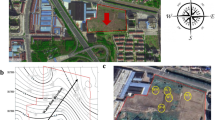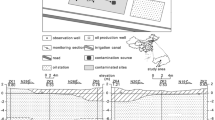Abstract
This research has been performed to determine the differences in microbial communities according to physicochemical properties such as concentrations of volatile aromatic hydrocarbons such as benzene, toluene, ethylbenzene, and xylene (BTEX), dissolved oxygen (DO), electron acceptors, etc., in oil-contaminated groundwaters at Kyonggi-Do, South Korea. The properties of bacterial and microbial communities were analyzed by 16S polymerase chain reaction (PCR) denaturing gradient gel electrophoresis (DGGE) fingerprinting method and community-level physiological profiling (CLPP) using Eco-plate, respectively. Based on the DGGE fingerprints, the similarities of bacterial community structures were high with similar DO levels, and low with different DO levels. Whereas the dominant bacterial groups in GW13 (highest BTEX and lowest DO) were acidobacteria, α-proteobacteria, β-proteobacteria, γ-proteobacteria, δ-proteobacteria, and spirochetes, those in GW7 (highest BTEX and highest DO) were actinobacteria, α-proteobacteria, β-proteobacteria, γ-proteobacteria, δ-proteobacteria, and sphingobacteria. Based on the CLPP results, the groundwater samples were roughly divided into three groups: above 4 mg/L in DO (group 1: GW3 and GW7), below 4 mg/L in DO (group 2: GW8, W1, W2, W3, and BH10), and highly contaminated with BTEX (group 3: GW13). Shannon index showed that the microbial diversities and equitabilities were higher in shallower aquifer samples. Overall, this study verified that the greatest influencing factors on microbial/bacterial communities in groundwaters were DO and carbon sources, although BTEX concentration was one of the major factors.








Similar content being viewed by others
References
Amann RI, Ludwig W, Schleifer KH (1995) Phylogenetic identification and in situ detection of individual microbial cells without cultivation. Microbiol Rev 59:143–169
Baldwin BR, Nakatsu CH, Nebe J, Wickham GS, Parks C, Nies L (2009) Enumeration of aromatic oxygenase genes to evaluate biodegradation during multi-phase extraction at a gasoline-contaminated site. J Hazard Mater 163:524–530
Barcelona MJ, Lu J, Tomczak DM (1995) Organic acid derivatization techniques applied to petroleum hydrocarbon transformations in subsurface environments. Ground Water Monit Rem 15:114–124
Cavalca L, Della Amico E, Andreoni V (2004) Intrinsic bioremediability of an aromatic hydrocarbon-polluted groundwater: diversity of bacterial population and toluene monoxygenase genes. Appl Microbiol Biotechnol 64:576–587
Cho W, Lee EH, Shim EH, Kim J, Ryu HW, Cho KS (2005) Bacterial communities of biofilms sampled from seepage groundwater contaminated with petroleum oil. J Microbiol Biotechnol 15:952–964
Cozzarelli IM, Eganhouse RP, Baedecker MJ (1990) Transformation of monoaromatic hydrocarbons to organic acids in anoxic groundwater environment. Environ Geol Water Sci 16:135–141
Da Silva MLB, Alvarez PJJ (2002) Effects of ethanol versus MTBE on benzene, toluene, ethylbenzene, and xylene natural attenuation in aquifer columns. J Environ Eng 128:862–867
Fang J, Barcelona MJ (1998) Biogeochemical evidence for microbial community change in a jet fuel hydrocarbons-contaminated aquifer. Org Geochem 29:899–907
Findlay RH, Trexler MB, Guckert JB, White DC (1990) Response of a benthic microbial community to biotic disturbance. Mar Ecol Prog Ser 62:135–148
Garland JL (1997) Analysis and interpretation of community-level physiological profiles in microbial ecology. FEMS Microbiol Ecol 24:289–300
Garland JL, Mills AL (1991) Classification and characterization of heterotrophic microbial communities on the basis of patterns of community-level, sole-carbon-source utilization. Appl Environ Microbiol 57:2351–2359
Haack SK, Garchow H, Klug MJ, Forney LJ (1995) Analysis of factors affecting the accuracy, reproducibility and interpretation of microbial community carbon source utilization patterns. Appl Environ Microbiol 61:1458–1468
Harayama S, Hara A, Baik S, Shutsubo K, Misawa N, Smits THM, van Beilen JB (2004) Cloning and functional analysis of AlkB genes in Alcanivorax borkumensis SK2. Environ Microbiol 6:191–197
Hendrickx B, Dejonghe W, Boenne W, Brennerova M, Cernik M, Lederer T, Bucheli-Witschel M, Bastiaens L, Verstraete W, Top EM, Diels L, Springael D (2005) Dynamics of an oligotrophic bacterial aquifer community during contact with a groundwater plume contaminated with benzene, toluene, ethylbenzene, and xylenes: an in situ mesocosm study. Appl Environ Microbiol 71:3815–3825
Holmes DE, O’Neil RA, Vrionis HA, N’Guessan LA, Ortiz-Bernad I, Larrahondo MJ, Adams LA, Ward JA, Nicoll JS, Nevin KP, Chavan MA, Johnson JP, Ling PE, Loveley DR (2007) Subsurface clade of Geobacteraceae that predominates in a diversity of Fe(III)-reducing subsurface environments. ISME J 1:663–677
Kim J, Kang SH, Min KA, Cho KS, Lee IS (2006) Rhizosphere microbial activity during phytoremediation of diesel-contaminated soil. J Environ Sci Health A Tox Hazard Subst Environ Eng 41:2503–2516
Konopka A, Oliver L, Turco RF (1998) The use of carbon substrate utilization patterns in environmental and ecological microbiology. Microb Ecol 35:103–115
MacNaughton SJ, Stephen JR, Venosa AD, Davis GA, Chang YJ, White DC (1999) Microbial population changes during bioremediation of an experimental oil spill. Appl Environ Microbiol 65:3566–3574
Moss A, Bassall M (2006) Effects of disturbance on the biodiversity and abundance of isopods in temperature grasslands. Eur J Soil Biol 42:S254–S268
Preston-Mafham J, Boddy L, Randerson PF (2002) Analysis of microbial community functional diversity using sole-carbon-source utilization profiles—a critique. FEMS Microbiol Ecol 42:1–14
Rajendran N, Matsuda O, Urushigawa Y, Simidu U (1994) Characterization of microbial community structure in the surface sediment of Osaka bay, Japan, by phospholipid fatty acid analysis. Appl Environ Microbiol 60:248–257
Skubal KL, Barcelona MJ, Adriaens P (2001) An assessment of natural biotransformation of petroleum hydrocarbons and chlorinated solvents at an aquifer plume transect. J Contam Hydrol 49:151–169
Smalla K, Wachtendorf U, Heuer H, Liu WT, Forney L (1998) Analysis of BIOLOG GN substrate utilization patterns by microbial communities. Appl Environ Microbiol 64:1220–1225
Song D, Katayama A (2005) Monitoring microbial community in a subsurface oil contaminated with hydrocarbons by quinone profile. Chemosphere 59:305–314
Acknowledgments
This research was supported by a grant by Sustainable Water Resources Research Center (1-0-3). Ms. Kim, J. Y. and Koo, S. Y. were financially supported by the Korea Science and Engineering Foundation through the Advanced Environmental Biotechnology Research Center at Pohang University of Science and Technology (R11-2003-006-06001-0). Ms. Lee, E. H. was also financially supported by the KOSEF NRL Program grant funded by the Korea government (MEST) (R0A-2008-000-20044-0).
Author information
Authors and Affiliations
Corresponding author
Rights and permissions
About this article
Cite this article
Lee, EH., Kim, J., Kim, JY. et al. Comparison of microbial communities in petroleum-contaminated groundwater using genetic and metabolic profiles at Kyonggi-Do, South Korea. Environ Earth Sci 60, 371–382 (2010). https://doi.org/10.1007/s12665-009-0181-7
Received:
Revised:
Accepted:
Published:
Issue Date:
DOI: https://doi.org/10.1007/s12665-009-0181-7




